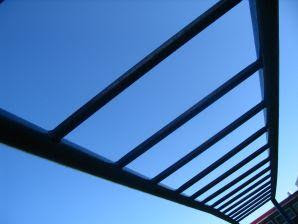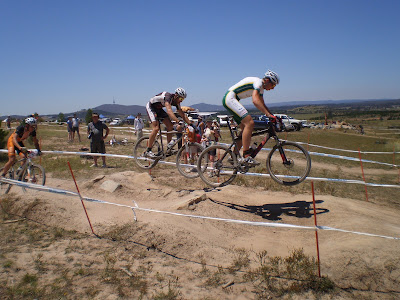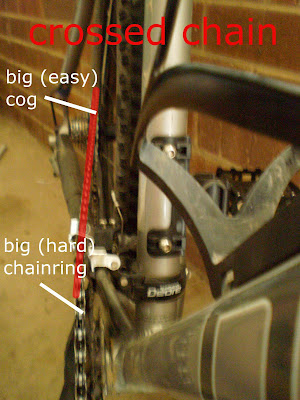I've been intrigued by single speeding/fixed gear riding and bikes lately and am pretty keen on building my own fixie from an old-school roadie. Apart from the training benefits that can be achieved from fixed gear riding (strength, peddling technique, leg speed etc.) fixies are just cool. There's a pretty sweet website called My Fixed Gear where people upload images of their bikes - it has some nice creations. I also found this awesome clip on YouTube that really shows what's capable on a fixie! check it!
Saturday, October 17, 2009
Sunday, July 5, 2009
Get Stronger Bike Handling Skills - Grip Training
Have you ever come to the end of a long ride or race and could barely grip the handlebars? Your weak hands are not only putting you at greater risk of falling off but are forcing you to ride slower at a time where you need speed the most. Strengthening hour hands/forearms can greatly improve your bike handling skills as you will gain a stronger grasp on the handle bars which will lead to better control when cornering, jumping and riding through the rough. Stronger hands will also mean that you will be able to ride harder and faster for longer because you will be less fatigued as the hours pass. There are a number of ways you can strengthen your grip without expensive hand strengthening gizmos.
Shock Pump/Arm Pump = fatigue in your fore arms derived from absorbing shock when riding down rough trails. To reduce shock pump, take a look at some of the exercises below:
- Chin Ups

All you need here are monkey bars or a chin-up bar. If you don't know what chin-ups are, basically all you do is hang from a bar and lift yourself up until your chin is above the bar, lower yourself then repeat. Lifting your body weight will give your hands a great workout as well as working your lats which are useful when pulling up on the handlebars.
- Just Hang There
If you can't do chin ups just hang on the bar for a while. Start by holding on with both hands and progress to holding with one hand. Run yourself through some timed sets and progressively overload your workouts.
- Tug-of-war
Roll up a towel, grab a friend and get each of you to hold onto either end of the towel with one hand and start tugging! This is a cheap and easy way to start strengthening your hands/fore arms.
Warning
When doing your grip exercises, make sure you don't over train as you will run the risk of Carpal Tunnel syndrome which can be quite painful.
Image courtesy of Steven Michelau
Friday, June 26, 2009
2009 World Mountain Bike Champoinships
That's right, the 2009 MTB Worlds will be held at Mt Stromlo in Australia's capital city, Canberra, which also happens to be my home town! The Success of the World Cup round that was held in August last year should give some insight into what's expected this year. The venue is only a few years old and I know that course preparations are well underway for the event in September.
If you are interested in racing at Mt Stromlo I took a look at the 2009 Australian National Championships not long ago.
Until next time...
If you are interested in racing at Mt Stromlo I took a look at the 2009 Australian National Championships not long ago.
Until next time...
Monday, June 15, 2009
The Future Of Mountain Bike Technology
Mountain biking and mountain bike technology has progressed so far since the first fat tyres were introduced - in fact, mountain bike/cycling technology is progressing faster than Formula 1! Back in the day when RoxShox introduced the first mountain bike suspension fork, the whole cycling world thought it was some kind of gimmick that wouldn't last - these days most people are afraid to even think of a world without their suspension. Anyone can agree that the margin between mountain bike technology from the 80's to 2009 is almost incomparable, but even bikes built a few years ago are starting to look a bit retro these days. With the relentless growth of this wonderful pastime and it's multiplying disciplines, mountain bike technology is going to keep progressing whether you like it or not. Here are a few of my predictions for the future of mountain bike technology:
No Derailleurs: gearboxes and single speeding are the next big things. I have noticed an increasing interest in single speeding of late, especially in Australia. The appeal comes from not only low maintenance and simplicity, but has sparked the interest of riders looking for a new challenge where a different kind of fitness and riding style is required. The current economic climate will also see people looking to the single speed side of riding due to its cheapness of purchase (comlete build), conversion kits and maintenance.
I sense that the mountain bike gearbox is about explode onto the mountain biking market. Since the introduction of the GT DHI a few years ago, we now have a number of readily available gearbox options including the Shimano Alfine, Rohloff Hub and Truvativ Hammerschmidt. The benefits I see from these gearbox systems are less risk of snagging your derailleur, quiet operation and instantaneous shifting. Gearbox technology will only improve - soon enough they will be lighter, smoother and cheaper, replacing the seemingly old-school derailleur.
Big Wheels: At the moment wheels bigger than standard 26" seem like a bit of a cult movement but at the rate the technology is progressing and the more commonly available these wheels/bikes are, they are sure to one day replace the 26" standard. I think once the perfect wheel size (29er, 69er, 96er, 650b etc.) and geometry is recognised, I'm sure they will become seen much more regularly on the trails.
Well that's all I've got for now - if I conjure up any more theories based on the future of mountain biking I will keep you posted. until then, YOU HEARD IT HEAR FIRST!
No Derailleurs: gearboxes and single speeding are the next big things. I have noticed an increasing interest in single speeding of late, especially in Australia. The appeal comes from not only low maintenance and simplicity, but has sparked the interest of riders looking for a new challenge where a different kind of fitness and riding style is required. The current economic climate will also see people looking to the single speed side of riding due to its cheapness of purchase (comlete build), conversion kits and maintenance.
I sense that the mountain bike gearbox is about explode onto the mountain biking market. Since the introduction of the GT DHI a few years ago, we now have a number of readily available gearbox options including the Shimano Alfine, Rohloff Hub and Truvativ Hammerschmidt. The benefits I see from these gearbox systems are less risk of snagging your derailleur, quiet operation and instantaneous shifting. Gearbox technology will only improve - soon enough they will be lighter, smoother and cheaper, replacing the seemingly old-school derailleur.
Big Wheels: At the moment wheels bigger than standard 26" seem like a bit of a cult movement but at the rate the technology is progressing and the more commonly available these wheels/bikes are, they are sure to one day replace the 26" standard. I think once the perfect wheel size (29er, 69er, 96er, 650b etc.) and geometry is recognised, I'm sure they will become seen much more regularly on the trails.
Well that's all I've got for now - if I conjure up any more theories based on the future of mountain biking I will keep you posted. until then, YOU HEARD IT HEAR FIRST!
Sunday, March 29, 2009
Mountain Bike Psychology
Lately I've been thinking about the power of the mind and how it can greatly effect our performance. Think about it - if you're feeling flat or depressed, your performance levels are nowhere near that if your motivated and excited. So why don't we spend more time strengthening our mind to drive us into better performance?
Today we will be looking at powerful mind technique which is commonly recognized as imagery or visualisation. Practicing imagery/visualisation has been known to strengthen the pathways between your brain and the rest of your body which can improve your coordination with certain techniques. I can recall numerous skills that I have achieved with imagery/visualisation being a key additive to the technique's success. Imagery/visualisation is a great exercise to improve your ability to ride lines, rail corners, clear jumps and win races.
How To Do It
You can strengthen your brain-body pathways at any opportunity where you are doing nothing; it might be on the bus, in the waiting room or on the loo - but the best time for brain training is probably when you just get into bed at night when it is dark and quiet. Basically all you have to do is visualise yourself doing stuff! Like any training method, you will need to progressively overload your sessions - start with around 5 minutes at a time and gradually build the duration. After a few sessions your imagination ability will improve and so will the quality of your visualisation. Visualise yourself riding tricky lines through single track, clearing jumps you can't yet hit and cornering with precision for starters; you will be able to think of areas you want to improve depending on where you are at with your riding (you may look at riding relaxed and smoothly - floating over the terrain, having good peddling form, riding in a tight bunch etc.). When visualising, make sure you are using good riding technique so it can be converted into reality. It is important that when you are visualising yourself ride, you are looking through your own eyes as if you were riding, not as if you ware watching yourself from a distance.
If you are new to mountain biking or you are unsure on how to tackle a technique, watch videos (youtube) and/or better riders who can execute the skill to see how it is done properly. We can learn a lot from our downhill/free ride brethren so don't rule them out when observing skills.
Imagery Training On-The-Go
One thing I do a fair bit of is picking lines on any remotely rideable thing. If I'm walking down a staircase I'll visualise myself riding down the stairs. If I see an open rock face I will plan the best route to the bottom. Even if it is unlikely that I will be facing any of these obstacles in a single track situation, similar hazards on a smaller scale are sure to arise and I am able to attack them with more confidence because I have already pre-planned a bigger stunt.
Stay tuned for more psychology techniques to improve your riding, coming soon...
Today we will be looking at powerful mind technique which is commonly recognized as imagery or visualisation. Practicing imagery/visualisation has been known to strengthen the pathways between your brain and the rest of your body which can improve your coordination with certain techniques. I can recall numerous skills that I have achieved with imagery/visualisation being a key additive to the technique's success. Imagery/visualisation is a great exercise to improve your ability to ride lines, rail corners, clear jumps and win races.
How To Do It
You can strengthen your brain-body pathways at any opportunity where you are doing nothing; it might be on the bus, in the waiting room or on the loo - but the best time for brain training is probably when you just get into bed at night when it is dark and quiet. Basically all you have to do is visualise yourself doing stuff! Like any training method, you will need to progressively overload your sessions - start with around 5 minutes at a time and gradually build the duration. After a few sessions your imagination ability will improve and so will the quality of your visualisation. Visualise yourself riding tricky lines through single track, clearing jumps you can't yet hit and cornering with precision for starters; you will be able to think of areas you want to improve depending on where you are at with your riding (you may look at riding relaxed and smoothly - floating over the terrain, having good peddling form, riding in a tight bunch etc.). When visualising, make sure you are using good riding technique so it can be converted into reality. It is important that when you are visualising yourself ride, you are looking through your own eyes as if you were riding, not as if you ware watching yourself from a distance.
If you are new to mountain biking or you are unsure on how to tackle a technique, watch videos (youtube) and/or better riders who can execute the skill to see how it is done properly. We can learn a lot from our downhill/free ride brethren so don't rule them out when observing skills.
Imagery Training On-The-Go
One thing I do a fair bit of is picking lines on any remotely rideable thing. If I'm walking down a staircase I'll visualise myself riding down the stairs. If I see an open rock face I will plan the best route to the bottom. Even if it is unlikely that I will be facing any of these obstacles in a single track situation, similar hazards on a smaller scale are sure to arise and I am able to attack them with more confidence because I have already pre-planned a bigger stunt.
Stay tuned for more psychology techniques to improve your riding, coming soon...
Wednesday, January 28, 2009
2009 National MTB Championships
Last weekend (January 23/26) saw the 2009 MTBA National Mountain Bike Championships held at Mt. Stromlo, Canberra. I was unfortunate enough to miss competing myself but I was able to get a glimpse of the short-course racing that was held on Monday. The course was relatively long with the odd short-sharp climb accompanied by a few jumps and tight bermed corners. The riding was hot being held at the height of a 38 degrees Celsius (100.4 F) day. The track was broken in by the Sport Men division where a strong riding standard was set, followed by the massive swarm U19 Male competitors. The Women's short course was next where a strong lineup of riders made there presence felt. The elite men finished the series of racing off with a high-paced dust fight. Olympian Chris Jongewarrd took the whole-shot and gave himself a big 15 second buffer and rode alone for most of the race. After working well together, local rider Dylan Cooper and Victorian Daniel McConnel managed to pull Jongewarrd's lead back to a manageable distance for an exciting finish with Jongewarrd in 1st, Cooper in 2nd and McConnel in 3rd.



For more information on the event and venue visit http://www.mtbnationals.com.au/ and stromloforestpark.com.au
For more information on the event and venue visit http://www.mtbnationals.com.au/ and stromloforestpark.com.au
Tuesday, January 13, 2009
Which Gear?
Our drive train can handle whatever gear combination we plug in right? WRONG! It is imperative that we know how to work with our drive train to prevent unnecessary wear and expensive damage; not to mention performance advantages.
Don't Cross Your Chain
Your chain has been crossed when you are in the big chainring at the front and a big chainring at the back (eg. 3x1), or the small chainring at the front and a small chainring at the back (eg. 1x9). Riding in these sort of gear ratios puts extra strain on your chain which can lead to premature chain/cog wear and most likely a snapped chain.


When shifting you should always be wary of the ratio you are in. When you are in the middle ring upfront you can use most of the range in your rear cassette but your drive train may struggle with the smallest and biggest few cogs at the rear. When in the smallest (easiest) chainring upfront you don't want to exceed the inner half of the rear cassette which contains the larger (easier) cogs. The same principle applies when in the big (hardest) chainring upfront - stick to the smaller (harder) gears at the back. The straighter the line of your chain, the less strain it is under.

Don't Cross Your Chain
Your chain has been crossed when you are in the big chainring at the front and a big chainring at the back (eg. 3x1), or the small chainring at the front and a small chainring at the back (eg. 1x9). Riding in these sort of gear ratios puts extra strain on your chain which can lead to premature chain/cog wear and most likely a snapped chain.
When shifting you should always be wary of the ratio you are in. When you are in the middle ring upfront you can use most of the range in your rear cassette but your drive train may struggle with the smallest and biggest few cogs at the rear. When in the smallest (easiest) chainring upfront you don't want to exceed the inner half of the rear cassette which contains the larger (easier) cogs. The same principle applies when in the big (hardest) chainring upfront - stick to the smaller (harder) gears at the back. The straighter the line of your chain, the less strain it is under.
Subscribe to:
Posts (Atom)
